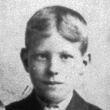George Marshall Directed This Film Noir
This film noir, based on a novel by Raymond Chandler, contains all the standard conventions of the genre: the not-entirely-on-the-level hero in over his head, the femme fatale, the (true) love interest, the strangely sympathetic and idiosyncratic villains, the friends or associates, the aura of whodunit, a twisty plot,  lots of rain, and the secret darkness of postwar Los Angeles, with its housing shortages, guys who will punch you in the kidneys, and the lurking presence of illicit sexuality, without that Good Housekeeping seal of approval. This Spanish movie poster communicates almost all of this, if you really look at it. There is certainly no shortage of similar films in this year: The Big Sleep, Gilda, Crack-Up, The Killers, The Postman Always Rings Twice, and The Strange Love of Martha Ivers. Even Hitchcock's Notorious and Welles’s The Stranger partake of noir. The film was shot in under two months in 1945, just as the Allies were victorious in Europe, and produced by the great actor and theatrical entrepreneur John Houseman.
lots of rain, and the secret darkness of postwar Los Angeles, with its housing shortages, guys who will punch you in the kidneys, and the lurking presence of illicit sexuality, without that Good Housekeeping seal of approval. This Spanish movie poster communicates almost all of this, if you really look at it. There is certainly no shortage of similar films in this year: The Big Sleep, Gilda, Crack-Up, The Killers, The Postman Always Rings Twice, and The Strange Love of Martha Ivers. Even Hitchcock's Notorious and Welles’s The Stranger partake of noir. The film was shot in under two months in 1945, just as the Allies were victorious in Europe, and produced by the great actor and theatrical entrepreneur John Houseman.
The Plot
John Morrison, the hero (Alan Ladd), returns from the war a decorated Navy commander only to discover that his lady wife, Helen (Doris Dowling), has been unfaithful to him with at least one man, the oddly engaging Eddie Harwood (Howard da Silva), and maybe more. For those who enjoyed The Best Years of Our Lives, also produced in 1946, you might remember that a similar hero, Dana Andrews, comes home to an almost identical L.A. bungalow also to find his adulterous wife throwing all kinds of parties for men she has been sleeping with while he has been off fighting the Japanese.  In Dahlia, part of the sadness at the root of the hero’s psyche, besides the horrors of war and the sense of displacement at his return Stateside, is that he and his wife lost their only child, a little boy who allegedly died of diphtheria while he was in the service, perhaps an attempt at explaining Helen’s promiscuity and hostility. As is common to the genre, she ends up dead under mysterious circumstances, and John is blamed. In his attempts to avoid capture, he meets a golden girl (Veronica Lake), who just happens to be Joyce Harwood, the estranged wife of Eddie. That's when things get very interesting indeed. The film also features William Bendix (Buzz) and Hugh Beaumont (George), whom most aficianados of 1950’s Hollywood culture will remember as Mr. Cleaver in what is generally acknowledged to be, by all sensible people, the finest sitcom in the history of Western Christendom. In a very nice touch, the villainous Leo, bedeviled by poor eyesight and gout, and who keeps soaking his feet and wiping his glasses even as he is kidnapping John and hitting him with a blackjack, is on the receiving end of one of the more remarkable assaults in the movies, truly contrapasso. The actor who played him, Don Costello, died a few months after the film wrapped production. The Blue Dahlia was also, unfortunately, the last reputable film in which Veronica Lake appeared.
In Dahlia, part of the sadness at the root of the hero’s psyche, besides the horrors of war and the sense of displacement at his return Stateside, is that he and his wife lost their only child, a little boy who allegedly died of diphtheria while he was in the service, perhaps an attempt at explaining Helen’s promiscuity and hostility. As is common to the genre, she ends up dead under mysterious circumstances, and John is blamed. In his attempts to avoid capture, he meets a golden girl (Veronica Lake), who just happens to be Joyce Harwood, the estranged wife of Eddie. That's when things get very interesting indeed. The film also features William Bendix (Buzz) and Hugh Beaumont (George), whom most aficianados of 1950’s Hollywood culture will remember as Mr. Cleaver in what is generally acknowledged to be, by all sensible people, the finest sitcom in the history of Western Christendom. In a very nice touch, the villainous Leo, bedeviled by poor eyesight and gout, and who keeps soaking his feet and wiping his glasses even as he is kidnapping John and hitting him with a blackjack, is on the receiving end of one of the more remarkable assaults in the movies, truly contrapasso. The actor who played him, Don Costello, died a few months after the film wrapped production. The Blue Dahlia was also, unfortunately, the last reputable film in which Veronica Lake appeared.
Great Quotation
Noir is famous, even notorious, for snappy, sometimes insolent dialogue. Think of Bogart’s comment to Bacall in The Big Sleep, when he explains to her that her little sister has been “trying to sit in my lap while I was standing up.” In The Blue Dahlia, John’s retort to Joyce’s “You've never seen me before” is “Every guy’s seen you before. The trick is to find you.” Great romantic compliment or supremely rude? The not-quite-a-couple seems to end up together.
 The Blue Dahlia (1946)
The Blue Dahlia (1946)